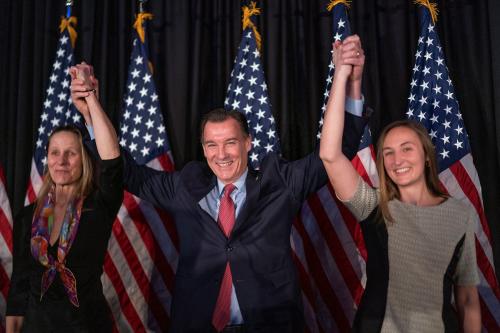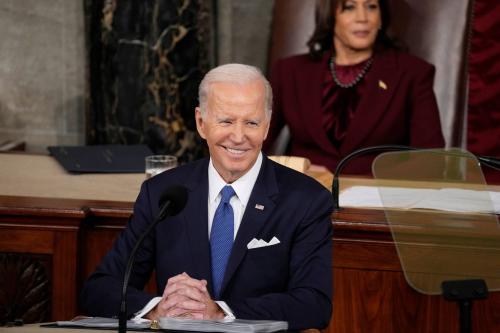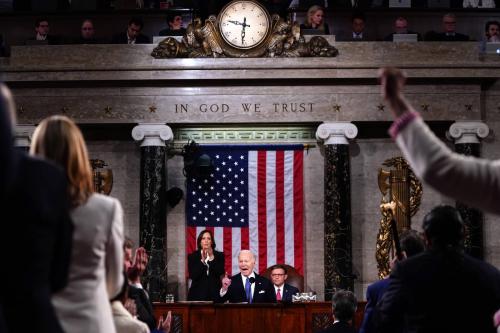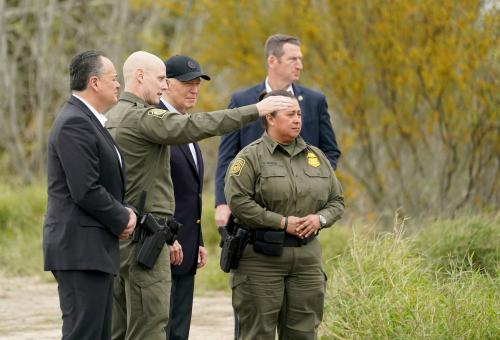Last October, Senate Republicans made it clear that they would not back additional aid for Ukraine without a bill that would help secure the southern border of the United States. With the blessing of both Senator Chuck Schumer, the Majority Leader, and Senator Mitch McConnell, the Minority Leader, a bipartisan team of senators began negotiations to produce a bill that enough members of both parties could accept to overwhelm objections from progressive Democrats and America First Republicans.
The team negotiated for four months to produce this bill. It took less than four days for its support among Republicans to collapse. Why?
The easiest explanation is that Republicans in both the House and Senate yielded to objections from their all-but-certain presidential nominee, former president Donald Trump. Once the House Speaker stated publicly that he would not allow the Senate bill to reach the House floor for a vote, Republican senators were unwilling to run the political risk of supporting a measure that would not become law.
However, there are deeper reasons for the deadlock over immigration. The last comprehensive immigration reform was enacted almost four decades ago, during Ronald Reagan’s presidency. This bill represented a grand bargain between elected officials who sought to extend legal protection to millions of migrants who had entered the U.S. illegally and officials who were most concerned about stemming the flow of such migrants. The bill accomplished the former but had no discernible impact on the latter, leading many conservatives to denounce it as an “amnesty” bill.
This history colored the next two decades of efforts to pass immigration reform legislation. In President George W. Bush’s second term, two such efforts failed after encountering a crossfire of objections from both the left and the right. The best chance to enact comprehensive reform came in 2013 during President Barack Obama’s second term, when a bipartisan group of senators dubbed the “Gang of Eight” agreed on a bill that would toughen security at the southern border and make it harder for employers to hire migrants who had entered the U.S. illegally while providing legal status and a path to citizenship for millions of such migrants who had resided in the U.S. for many years. The proposal passed the Senate 68 to 32 with strong bipartisan support. But because it did not enjoy the support of a majority of House Republicans, then-Speaker John Boehner refused to bring it to floor for a vote, and the measure died.
As partisan polarization deepened over the ensuing decade, the odds of agreement on meaningful immigration reform fell steadily. Donald Trump, whose campaign against illegal immigration helped him win the presidency in 2016, put in place through executive orders measures — such as separating children from their parents — that his administration defended as tough but necessary and Democrats denounced as cruel and inhumane. As the Covid-19 pandemic exploded in 2020, moreover, the Trump administration employed emergency public health measures to all but close the southern border to unauthorized border crossers. During the administration’s final year, encounters with migrants at the border fell to 458,000, an average of less than 40,000 per month.
President Trump’s policies aroused vehement opposition from many Democrats, and the party’s presidential nominee pledged to end them. When Joe Biden took office, he was as good as his word. Unfortunately, the policies with which he replaced Trump’s measures failed to manage the southern border effectively. Encounters with migrants at the southwestern border rose to 1.7 million in FY 2021, 2.4 million in FY 2022, and 2.5 million in FY 2023. (In addition, an estimated 600,000 entered the U.S. undetected, without encountering border agents, in FY 2023.) During the first quarter of FY 2024 (October 1, 2023-December 31, 2023) encounters totaled 785,000, putting the United States on pace for 3.1 million encounters during the current fiscal year.
Further complicating the task of managing the southern border was an historic change in the nature and sources of unauthorized border crossers. During the final decades of the 20th century, most of such crossers were working-age young Mexican men. But during the current century, the mix shifted to families from Central America and beyond who sought asylum in the United States by claiming a “reasonable fear of persecution” in their country of origin.1
The evidence suggests that most asylum seekers were fleeing poverty, lack of economic mobility, crime, and political disorder — all good reasons for leaving but these do not meet the standard for being granted asylum. Nevertheless, the law requires that asylum claims be assessed on a case-by-case basis, and as the number of cases rose sharply, the institutions responsible for adjudicating them were overwhelmed. During the past decade, the share of immigration cases resolved each year has fallen by half, and the backlog of pending cases rose from about 400,000 in 2013 to more than 3.1 million by the end of 2023. Few were held in detention for long periods; most were released into the U.S. with court dates far in the future, a policy that critics denounced as “catch and release.”
In an effort to relieve the pressure at the border, President Biden dramatically expanded the use of his “parole” authority in January 2023 to permit up to 30,000 individuals from Cuba, Haiti, Nicaragua, and Venezuela to legally enter the United States each month and to remain here for up to two years. This authority does not provide a pathway for parole recipients to remain in the country permanently, and immigration officials may revoke parole status at any time. A coalition of 20 Republican-led states is suing the Biden administration to end this program, which they see as an abuse of the president’s authority designed to increase the flow of migrants into the country.
Led by the Republican governors of Florida and Texas, opponents of Biden’s approach helped transport these migrants to big cities controlled by Democrats thousands of miles from the border. As the costs mounted for these cities, it did not take long for Democratic mayors to press the White House for relief. By last week, President Biden promised that he would shut the border if Congress gave him to legal authority to do so.
It’s not hard to see why. Public concern about immigration is high and rising, and Biden receives lower marks for his handling of immigration — 35% approval — than for any other issue.
By the fall of 2023, Democrats were willing in principle to support a bill that focused entirely on border security without provisions to legalize the status of any migrants who had entered the country illegally, not even the “Dreamers” brought to the United States by their parents while they were infants and children and who knew no other country. The Senate team produced such a bill, but it did not meet Republican demands, for substantive as well as political reasons.
In the first place, many Republicans believe that the president already has all the legal authority he needs to do what needs to be done, including closing the border, and they view the Senate bill as limiting rather than enhancing executive authority. Second, many Republicans are using the border security bill the House passed early last year, HR 2, as their benchmark. Among other provisions, this bill would end President Biden’s parole program, dramatically reduce the grounds for claiming asylum, reinstate the Trump-era “Remain in Mexico” policy, and force Biden to resume building President Trump’s border wall. Measured against this standard, the Senate bill’s compromises on asylum and border closure are bound to appear timid half-measures that will not get the job done.
Finally, many Republicans are prepared to wait until 2025 to address border security. If Donald Trump defeats President Biden and reenters the Oval Office, they believe that they will get everything they want without enacting compromise legislation that would limit Trump’s powers. In the meantime, they believe, the issue is damaging Biden, and they do not see why they should help him during an election year.
We will never know what would have happened if compromise legislation had been put on the table last year while it was uncertain whether Trump would be the Republican nominee for the third consecutive time. Now that we know that he will be, no compromise on immigration is possible. The remaining question is whether aid for Ukraine can be continued without such a compromise. If not, Donald Trump’s gain will also be Vladimir Putin’s.
-
Footnotes
- Alan Bersin, Nate Bruggeman and Ben Rohrbaugh, “Migration at the U.S- Mexico Border: A Challenge Decades in the Making” (Migration Policy Institute, January 2024).










Commentary
The collapse of bipartisan immigration reform: A guide for the perplexed
February 8, 2024